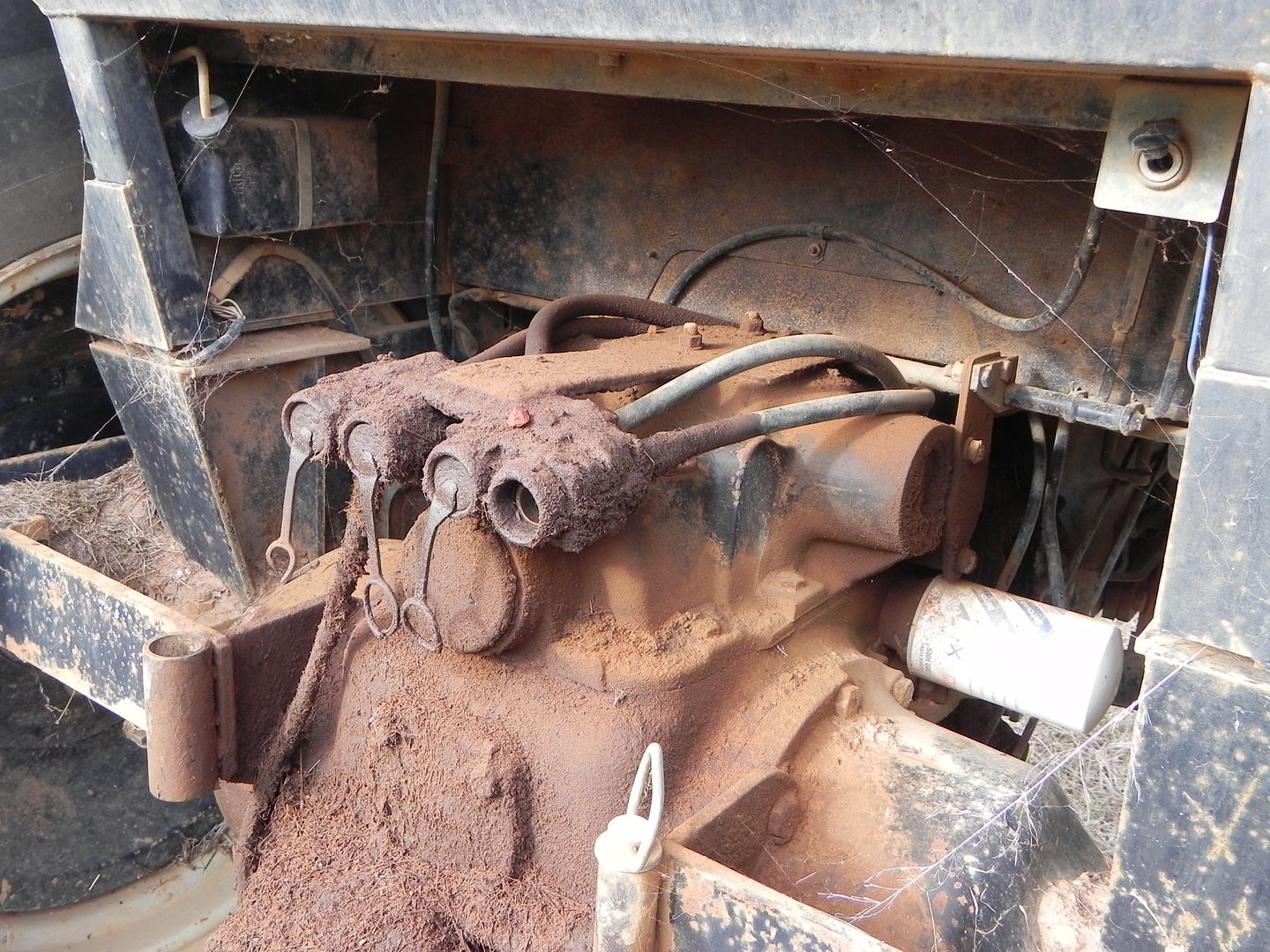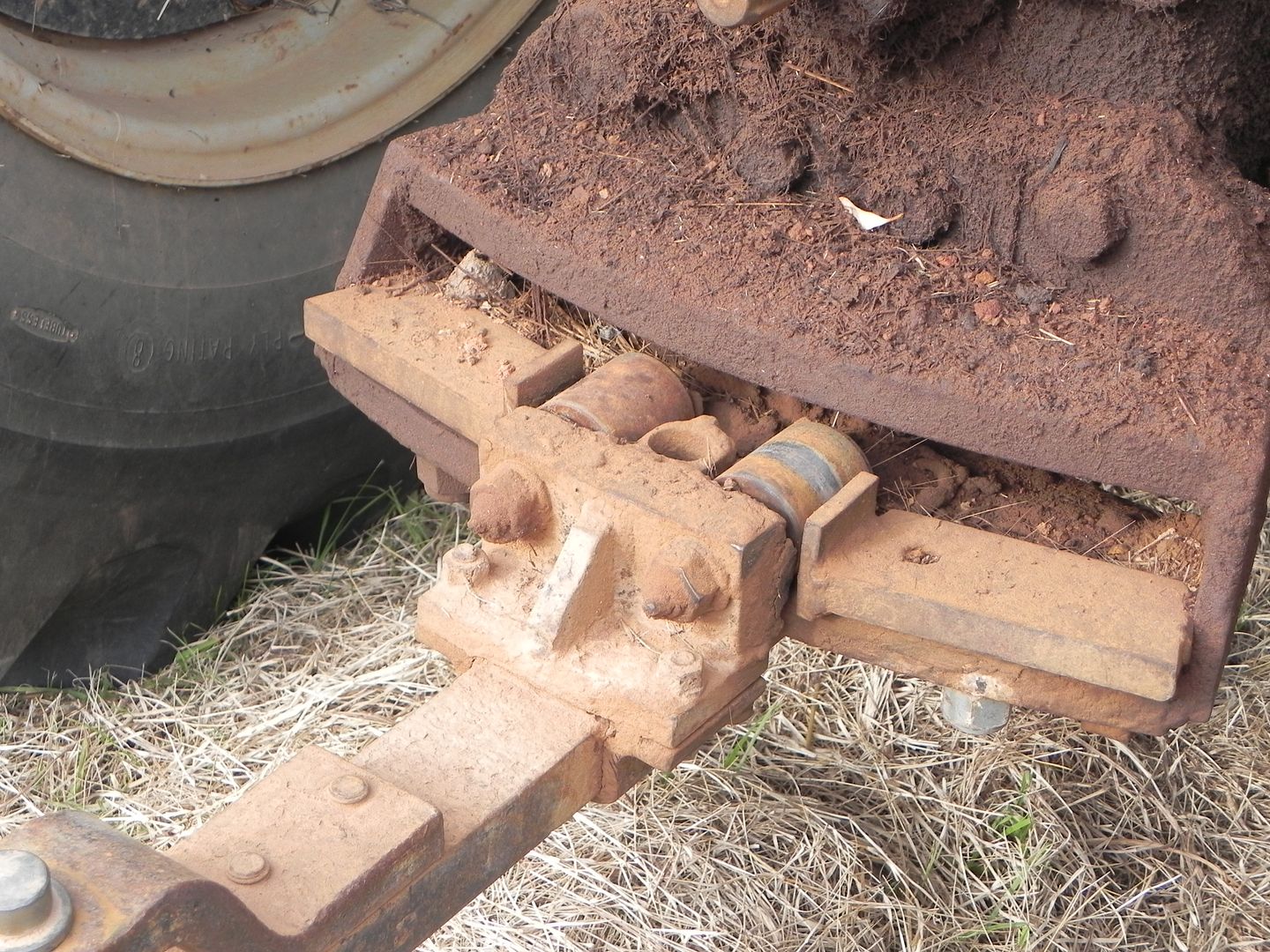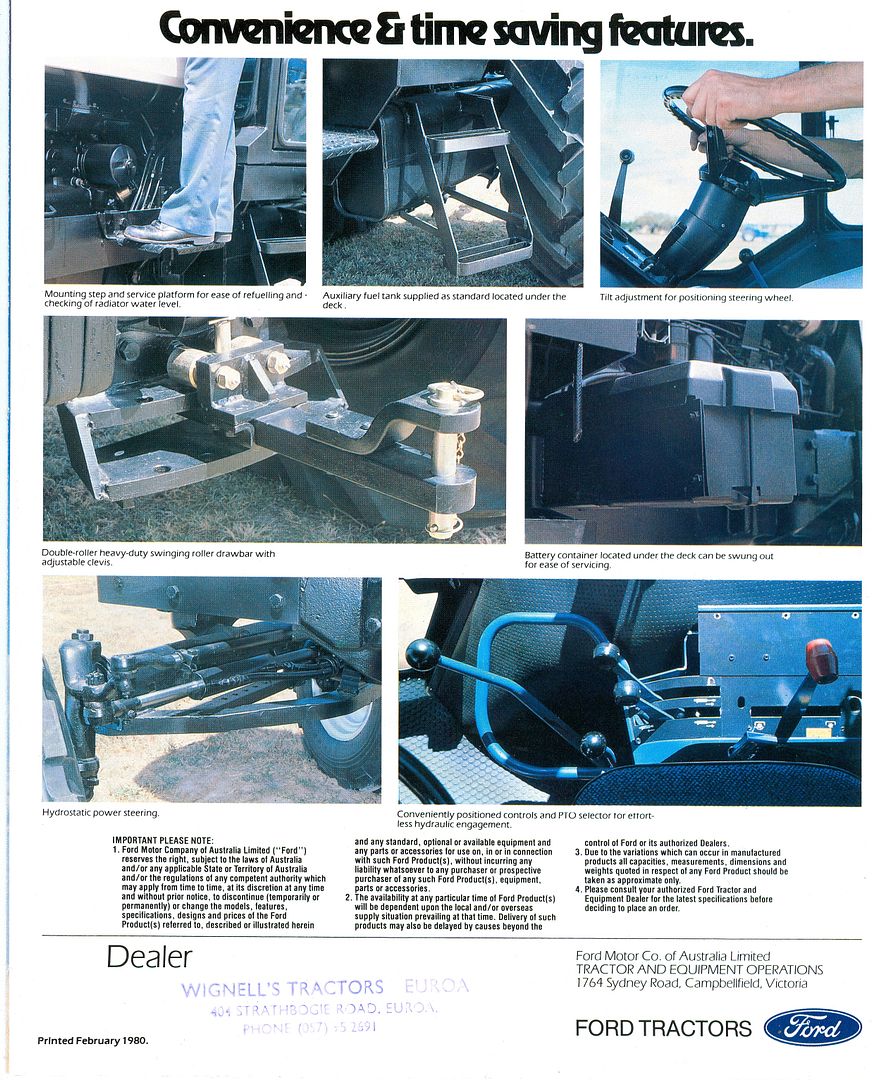 |
Show Changes |
 |
Edit |
 |
|
 |
Recent Changes |
 |
Subscriptions |
 |
Lost and Found |
 |
Find References |
 |
Rename |
| Search |
History
| 7/4/2012 12:55:13 PM |
| -86.132.180.77 |
| 6/29/2012 10:00:00 AM |
| -86.132.180.77 |
| 10/19/2011 6:08:39 PM |
| -81.155.28.233 |
| 10/19/2011 5:53:46 PM |
| -81.155.28.233 |
| 10/13/2011 9:42:35 PM |
| -81.155.29.117 |
 |
List all versions |
Ford 8401
I saw my first Ford 8401 in a tractor magazine in the 1990’s and was immediately struck by its clean lines and colour scheme, totally different from the Fords on offer at that time here in England. In the passing years I never again saw reference to it until Barry Milsom sent me detail of Australian Fords and their many differences to the other products Ford sold throughout the world.
When we were invited to visit Barry, Dawn and The Fordson Tractor Club of Australia in 2011 and started to plan the trip, one of the factors that clinched my decision to fly for the first time was the opportunity to meet an 8401 face to face and see if the real thing was as evocative to me as the pictures had been. I was not disappointed. We met in the farm yard and I was immediately smitten by the clean lines and shape. It was a bit like meeting the Petrol Dexta for the first time, here was a tractor that I had not heard of for many years and I was allowed to drive it!


It sounds silly to be so enthusiastic about a tractor but .. Hey … That’s what its all about. If I had the money I would add two tractors to my collection, one would be the Guldner for its sleek sports car lines and striking colour and the other would be the 8401. Who knows what the lottery tickets will bring!
Other features of the 8401 are the huge rear wheels and the lack of lift linkage although a hydraulic pump is fitted to operate the spool valves.


The lack of linkage and the massive drawbar seem strange to European eyes that are used to mounted implements that seem to get bigger every day.
I wondered why Ford produced this tractor. Later tractors in their range were very similar, the 8210 is a case in point which used the same engine and transmission assembled by County Commercial Cars, at Fleet in Hampshire from components issued by Ford at Basildon. Was the “8401” a trial for these? Or was it that people in the Ford organisation, like David Pearson, who campaigned for a six cylinder tractor here in Europe, were seeing markets that the Ford upper management did not. The TW series tractor were being produced in Basildon and Antwerp for world markets but there was a market for a slightly different product.. I mentioned these points to Barry and Dawn and also posted them on the web site.
This caused Ian Denton to contact me and with his permission I have reproduced the article he sent me. Read and enjoy. I certainly did, it is a first class account of the thinking behind the tractor from someone who was there from (nearly) Day 1.

In Australia in the late 1970’s Ford were loosing some market share to Chamberlain Tractors for two reasons …. Price and customer preference for six cylinder engines in the 100 to 115 horse power range.
The Australian government were heavily subsidising Chamberlain because it was the only Australian made Tractor.
The manager of Ford Tractor Operations at that time, Mr Noel Howard, was keen to provide the Australian farmers with an alternative cheaper six cylinder tractor and, I think it was his idea,(perhaps with input from other company personnel), to join a six cylinder engine to an existing transmission and final drive.
In the factory, they dismantled an 8700 tractor and a 7700 model and with the necessary small parts change, joined the six cylinder engine assembly to the transmission and final drive of the 7700, completing a new model of tractor, the first prototype!

Selected dealers from each state were chosen to attend a discussion meeting in Melbourne to put their points of view on this possible new Australian tractor from Ford. I was lucky enoughto be chosen from South Australia having had previous discussions with Noel Howard and was instrumental in the requests for a six cylinder tractor. We actually saw the made up tractor without bonnet and cabin, because the factory sheet metal did not fit. I do not know if anyone else has seen it but I have a photo of the fabricated mock-up cabin and bonnet, planned to be fitted.
Head Office (Engineering) did not approve of this project unless the engine horse-power was reduced and the final drive strengthened. By this time the TW10 tractor had come on stream and the new Australian tractor was going to be simply named “401” because it was a 401 cubic inch capacity engine, from a TW10, coupled to a standard 7700 Dual Power transmission. To fit Ford’s numbering system Overseas Engineering stated that it should be the “Ford 8401” and this is backed up by the “8” being a different colour to the “401” numbers. The prototype mock-up showed it only as “401”

To satisfy Engineering, the engine was de-rated to 109 horse-power simply by reducing the maximum fuel output from the injection pump and the final drive was fitted with a “County” crown wheel and pinion assembly requiring quite a few different associated parts.
By importing the engines and transmissions as skid units Ford were able to build the tractors in Melbourne but a supplier had to be found for the bonnet and cabin. After a lot of planning and drawing A.F.Gason of Ararat in Victoria, Tractor Cabin Manufacturers, were contracted to design and supply the cabins,bonnets and necessary attaching hardware.
To keep the tractor simple and the price competitive with Chamberlain, it was decided to supply the tractor as a drawbar only model with no 3 point linkage, same as supplied by Chamberlain. The drawbar assembly was of a double roller-wide swing design and the cabin only had a single door, again same as Chamberlain. The bonnet was made from Fibre Glass pivoting at the front and supported by two gas struts. Air conditioning was a must for Australian conditions and this was fitted in Australia. A double set of remote hydraulics were fitted as standard and a radio or cassette player was supplied as dealer fitment if the customer so desired.

When the State Representatives were called to Melbourne to inspect and comment on the new tractor we had to go through strict security. Into the Vehicle Design area, where the design was being progressed.
When the dealer body were all invited to Melbourne to learn about and inspect the new “8401” tractor, we were all seated in a stadium and were given a full introduction explaining the initial planning, told the features of this new tractor and to now witness the end result. Dealers were then asked to move out into the courtyard to inspect some of these tractors.

All dealers moved out except the Queensland dealers who made a point of staying seated, emphasising that the “8401” was not suitable for them if it did not have 3 point linkage and, because a lot of severe Power Take Off work, 540 and 1000 rpm PTO was required. These options came on stream some time later in various combinations.

A very small number were built using a different rear axle shaft/wheel centre combination and some were fitted with Dual Rear Wheels.

The initial production was coloured black, white and blue and was quite an attractive tractor, branching away from the traditional Ford blue. After about 3 years it was decided to give it a face-lift and the bonnet colour scheme was changed to an attractive blue/red design. At the same time the cabin also had some face-lift changes, the rear window was changed from “fixed” to opening with gas struts. The interior was lined with black vinl covering up exposed metal and welded areas. A good quality “Ford” floor mat was fitted, the outside locking door handle was now chromed in lieu of being galvanised and a cabin heater was optional on some models.

I was fortunate to represent South Australia to comment and participate in some design discussions, possibly because I showed a strong interest from the very beginning was told I sold the most “8401”s in South Australia but I had a distinct advantage because of my involvement. I actually had 10 to 12 sold before the release. (Subject to the customer being happy with the product when they arrived) and we actually received Serial Number 2 off the assembly line.
I believe the overseas engineers took quite an interest in what Australia were doing and I think the seeds were being planted for the Ford 8210 which followed some years later, but as with the passage of time, a new synchronised transmission was available but a lot of the basic characteristics remained. 4 pinion planetary final drives were fitted to the “8210”. A problem had shown up in some tractors when the final drive planetary gears failed. They were not worn but they appeared to split as if too highly tempered. Another theory was that the torque of the motor was too great. When replaced with the 4 pinion carrier assembly designed for the 8210 the problem was overcome.
The “8401” was very popular, a very good performer,always had at least the advertised horse-power and more, in fact we reduced the maximum output on several tractors when dyno-testing at the pre-delivery stage. (Detuning did not reduce the 401 cubic inch volume).

All in all, in my opinion, a very successful tractor for the Australian farmer of the day! A great idea from Ford of Australia.

Ian Denton,
Clare,
South Australia.
Notes on the business of “J.O.Denton and Sons, Farrells Flat, South Australia”.

J.O.Denton (Joe) left school at 11 years of age to work in his father’s grocery store.
In 1921 he started his own business “J.O.Denton” carrying out mechanical repairs and experimenting with wireless, building his own receivers and transmitters. He was transmitting before any commercial stations had started in South Australia.
In 1923 he also started selling and servicing Douglas “Belt Drive” Motorcycles.
In early 1926, not long after Ford started building Model “T” Fords at Geelong, he applied for a Ford franchise that commenced on May 1st 1926. His first Model ”T” was actually sold on February 17th 1926 and the first Model “F” Fordson tractor on October 17th 1926.
Other agencies included Caterpillar, Lanz Bulldog, H,V. McKay, Massey Harris, Atwater-Kent Wireless, Freelite and Delco Lighting Plants, etc.
With the introduction of the “E27N Fordson Major” other tractor brands were discontinued and the Fordson tractors were sold in very big numbers with approx. 70% market share. This market share reduced as many others came on stream in the late 1950’s but we always had very good market penetration with the New Majors, Power and Super Majors and the very successful 2/3/4/5000 Series, followed by the 7700’s, TW Models, 30 and 40 Series and the Australian Designed 8401 which we sold in big numbers.
Ian Denton started in 1954 handling the spare parts side of the business (and still does today, after retirement, as a hobby). Progressing to “Tractor and Equipment” sales in the early 1960’s. Joe retired in the 1970’s and Ian then ran the business until 2000.
When direct involvement with Ford, Ford New Holland and New Holland came to an end in 2000, Ian was presented with an award in recognition of the 75 years contious involvement with the Copany by the Denton Family business.
At that time the business had been directly involved with Ford/Fordson Tractors for 75 years of the 82 years of Ford Tractors in Australia. In fact 75 years of the 84 years of Ford Tractors in the WORLD.

(This article is the copyright of Ian Denton and Fordson Tractor Pages, it may not be re-produced on any format without the permission of the above parties).
I would very much like to thank, on behalf of The Fordson Tractor Pages Team, Barry and Dawn Milsom for arranging my visit to an 8401 and the owner for letting me photograph it and “play” and for copies of the leaflet which, I understand is a rare item. Also for their introduction to Ian who has let us print this wonderful exclusive insight into the development of the tractor.
Brian.
If you are new to Wiki, read OneMinuteWiki or VisitorWelcome.
Recent Topics